|
Father Martin Joseph Henni performed John’s baptism on 25 April 1843. The godparents were his mother’s brother-in-law,
Joseph Neikamp and a woman named Maria Gerve. It is probable that Maria Gerve emigrated from Gesmold, the same town of Katherine’s
origin.
Father Henni noted John’s birth date as 24 April. However, documents signed by John himself in his Civil War Pension
file and his death certificate show his date of birth as 22 April. Therefore, John was three days old when he was baptized
and his parents gave him the name of John Joseph. Typical to German Catholic tradition, the child received the name of the
respective godparent of the same sex, in this case, Joseph.
The family moved to Newport when John was about 5 years old. He grew up on Locust Street, two blocks from the Licking River.
Corpus Christi school was two blocks away and since boys attended school until the age of 10 or 12, John did the same.
In 1860, at the age of 17, John’s occupation is tailor, like that of his father. It is believed he worked in Cincinnati
and probably for the same employer as his father.
Civil War Service
The Civil War began in 1861 when John was 18 years old. Because of his age or that the Northern Kentucky area along the
Mason-Dixon line remained neutral during the conflict, John steered clear of service. Anxious to end the war and desperate
for men, in February 1865 President Lincoln authorized a $100 bounty to any able-bodied man who joined the infantry for one
year. John took advantage of this bounty and enlisted on 13 Feb 1865 in Cincinnati.
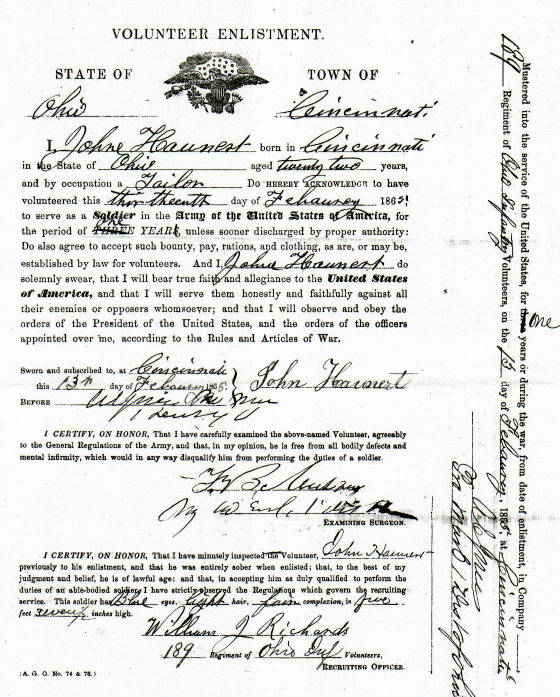
This document is John’s enlistment as a volunteer. He states that he is
22 years old but in reality he is still 21. His occupation is Tailor and holds his signature, which is quite legible. John
is physically described in the bottom section as having blue eyes, light hair, fair complexion and is five feet seven inches
in height.
John was assigned at first to the 189th Regiment of the Ohio Volunteer Infantry, known as the O.V.I. and reported
to Camp Chase as a Private on 25 March 1865. Camp Chase, a Confederate prison as well as induction center for new soldiers,
was located on the western outskirts of Columbus. He was reassigned to the newly formed 196th O.V.I. Company H.
John Haunert reported for duty here 25 March 1865
Bird's eye view of Camp Chase, near Columbus, Ohio
Drawn by A. Ruger
Creates/published by Cincinnati, Ehrgott, Fobriger & Co., (186-)
Depository at Library of Congress
Under Colonel R. P. Kennedy, the 196th joined the 2nd Brigade, 2nd Provisional Division of the Army of the Shenandoah,
under Major General Philip Sheridan and headed for Winchester, Virginia. Winchester, an important rail connection, was held
by the Union since late 1864. It is possible that John and his fellow soldiers arrived at Winchester during the final days
of the war which finally ended on 9 April 1865 at Appomattox Court House, less than 200 miles south of Winchester.
The men slept on the ground and were sheltered from inclement spring weather by canvas tents. It was at Stephenson Station,
near Winchester, that John Haunert became ill. He complained of chest and back pains and was treated by the Regimental Surgeon.
John was relieved of duty during his illness for three or four days.
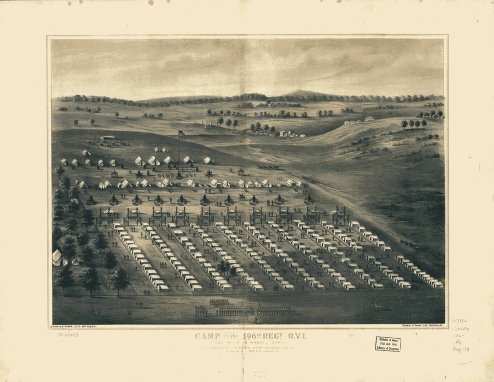 John Haunert contracted a lifelong illness here.
Camp of the 196th Regt. O.V.I. Col. R.P. Kennedy commanding
Stevenson's Station near Winchester, Virginia
Drawn by A. Ruger, Co. E, 196th Reg. OVI
Created/Published Baltimore, Md., Schmidt & Trowe (186-?)
Depository at Library of Congress
| 196th Ohio Valley Infantry Regimental Colors |

|
In July, the regiment was ordered to Baltimore and assigned to garrison duty at Fort Delaware. These fortifications held
men taken as prisoners from Confederate forces. Over the next few months, the 196th probably served as guards while
prisoners signed pledges of allegiance to the Union and then were released.
The 196th was mustered out on 11 September 1865. Twenty-five men lost their lives from disease,
none as casualties from action. John’s service lasted only 211 days.
His parents, a brother and three sisters greeted John on his homecoming from the war. His mother was pregnant with her
ninth child in 1865 and John’s last sibling, Joseph, was born that year on Christmas Day.
John returned to his occupation as a tailor. He met and married Maria Theresia Weier (Weyer) on Tuesday 15 May 1866. John
was 23 and his bride, 19. Father John Voll performed the ceremony at Corpus Christi Church, Newport, and Theresia’s
brother, Henry Weier, John’s sister, Catherine Haunert, and Henry Diekmann were witnesses.

The couple’s first child was born a year later and was named John Frank in honor of his father and grandfather. The
family grew to a total of nine children over the next twenty years. Fortunately, the family lost only one child at an early
age, Maria Theresia, namesake of her mother, at the age of 16 months.
For the next few years, John and his family lived in the neighborhood where he grew up. Around 1875 John purchased a house
at 74 Locust. At this time, John’s parents, sister Mary Bankemper, and Theresia’s parents also lived on Locust
Street. Couples with young children depended on other family members for many practical matters such as childcare but it was
also typical of German families to live close together and near their church. John and Theresia belonged to Corpus Christi
for the first twenty years of their marriage. The church was two blocks from their home.
Sometime around 1871 John became a cutter in the garment industry. Cutters were responsible for sizing the pattern and
fabric to specifications for a particular piece of clothing. The firm John worked for was James Lowman and Brothers, Shirt
Manufacturers, Importers and Dealers in Gents Furnishing Goods, located in Cincinnati at 110 West Pearl at Race Street.
Pearl Street is now the downtown section of Interstate 71 running east to west between Second and Third Streets.
John was promoted to foreman cutter in 1882 and held that position until about 1895. At one time two of John’s sons,
William and Henry worked as cutters at the firm. In 1890, the firm employed approximately 45 men and women in jobs as cutters,
seamstresses, and sales. Lowman’s existed from at least 1855 until at least 1901 and possibly longer.
After living on Locust Street for more than ten years, the family moved, probably to a larger home to accommodate their
seven children. John and Theresia purchased a house at 254 Central (later 926 Central) in 1885. On March 5, John paid $1,065
to Richard and Mary Walsh for lot number 187 in the Trustees Addition of the City of Newport. John was 40 years old. They
continued to be members of Corpus Christi but their youngest daughter, Catherine, was baptized at St. Stephen’s in 1887
and the family was complete. Nine children were born over a twenty-year period.
The next eight years, 1885-1893, were stressful ones for John and Theresia. Both sets of parents passed away during this
time. Theresia’s mother, Angela, died in 1885, Frank Haunert in 1887, Katherine in 1892 and Bernard, Theresia’s
father, died in 1893. It was also at this time that John began experiencing some health issues that made it difficult for
him to perform his work as a cutter.
On 20 July 1892 John opened a saloon at 10th and Saratoga streets and was "granted a license to sell by retail spirituous,
vinous and malt liquors for one year from this date". The saloon did not seem to be successful, as it does not appear as his
occupation or a place of business in any City Directory. However, three of John’s sons would open saloons at the turn
of the century in the Newport area.
Around this time, John learned that the government had passed a law to support soldiers who were ill or injured as a result
of the Civil War. It was the Act of 27 Jun 1890, and if approved would provide monthly income to men who proved their disability,
either full or partial, to the government.
On 9 October 1893 at age 50, John filed a declaration for Invalid Pension based on rheumatism and disease of the chest
and many other organs. In May of 1894 he added heart disease to his application. John’s claim was based on illness contracted
at Stevensons Station, Virginia in the summer of 1865 and that this illness rendered him unable to perform his duty and continued
after his discharge from service.
A rigorous process ensued, requiring John to undergo physical examinations and testimony by his private physician, Dr.
Henry Gunkel, and Military Physicians in Covington as well. Dr. Gunkel’s affidavit in May 1894 tells us John’s
medical history. His report states: "he has known John for 33 years and that prior to his enlistment was free of disease and
severe illness. At his return in the fall of 1865, John was treated for rheumatism and disease of the heart and urinary organs,
which are of Army origin caused, by exposure and malaria. That from 1865 to present John has been two-thirds disabled for
manual labor and many years past he has been totally and permanently disqualified for manual labor and has performed none".
Witnesses were needed to confirm that his illness was a result of military duty. Two soldiers from Company H, Frank Sherer
and Michael Scherer, both of Campbell County, Kentucky, testified to John’s complaints of pains in his chest and back
and that he was not fully recovered at discharge.
In addition, two employees at Lowman’s testified that they had known him for many years and that in the last year
he was a constant sufferer of pain in the chest and back, and had difficulty breathing at times.
It was determined that John had rheumatism affecting his right shoulder, left knee and left ankle leaving him with limited
motion. He was declared wholly disabled for hard manual labor but could perform light manual labor. John was awarded $6 a
month beginning 12 October 1893.
John filed several times over the next few years applying to increase his pension payments and again he underwent many
physical examinations. In 1898, John’s physical abilities had diminished to the point where he was unable to perform
any type of manual labor. The rheumatism and heart disease had advanced as well as pains in his joints left him helpless at
times, incapable even to dress himself.
Pension payments rose to $12 a month in 1898 and it is probable that John left his job as foreman cutter at Lowman’s
around this time. He would have been 55 years old.
According to John’s granddaughter, Estell Braun Anderson, John and Theresia made men’s suits by hand at home.
This leads us to believe that while John may have retired from Lowman’s, he continued his occupation as tailor. This
is supported by references to his employment as tailor on his pension applications. Perhaps friends, neighbors and other acquaintances
in Newport looked to the Haunerts for custom made outfits. Stell’s mother, Katherine, the youngest, kept house and cooked
for her parents so they could devote their time to tailoring.
John continued to receive pension payments throughout his life with an increase to $14 a month in 1906. When John turned
70, payments went to $19 a month with the final increase to $32 a month in June 1918.
In 1908, John’s personal physician, Matthias Stiggins, confirmed that over the last year John had been confined to
bed for one to two days on several occasions. John is 65 years old at this time.
Physician’s affidavits give an account of John’s physical description over the 15-year period of the pension
file. In May of 1894 at age 50 he is 5 feet 7½ inches, 170 pounds, light complexion, blue eyes and light hair. At age 54 he
is 5 feet 7 inches, 160 pounds with gray hair. The last report in June of 1908 at age 65, John is 155 pounds and his height
is 5 feet 6½ inches.
Beginning around 1892, John and Theresia’s children began to leave their home for employment and marriage. The eldest,
John Jr. lived in Covington in 1894 and was probably married by then to a woman named Mary. It is not believed that the couple
had any children except for a daughter from Mary’s previous marriage.
At the turn of the century on 3 January 1900, John Jr. died at the young age of 32. The cause of death and where is unknown
but was probably in Covington where John and his wife resided. He is buried at Mother of God Cemetery, Latonia, Kentucky along
side his widow.
Bernard appears to have moved from his parent’s residence just once around 1894 and except for this, lived his whole
life on Central. He never married.
Son Henry married Clara Betsch in 1892 and took up residence in Newport lived in Newport for many years. Their first daughter,
Mary Theresia, is probably the oldest grandchild of the elder Haunerts and was named after her grandmother who served as godmother
at her baptism at St. Stephen’s in August of 1893. Henry worked with his father as a cutter for a short time in 1895-96.
William married next. His bride, Mattie Betsch, was the youngest sister of Henry’s wife, Clara. They married in 1898
and lived in Newport in the early years of their marriage.
William and his brother Bernard operated a saloon called Haunert Brothers from 1897 to 1899 at 806 Isabella. William and
his new wife lived over the saloon for a few years. In 1900, Bernard left and brother Henry took his place. The saloon was
renamed "The Oak Saloon". By 1902, William was sole proprietor of the cafe, now called "The Elm Saloon" and moved it to 9th
and York Street.
August married in 1902 and Joseph in 1906. Both daughters, Sophia and Catherine married in 1908. Bernard was the only child
left with his parents. By this time they were beyond 60 years of age and perhaps Bernard cared for them.
The Legend of the Second Avenue Houses
John is infamous among family members for giving a house to each of his children on Second Avenue in Dayton, Kentucky.
City Directories and other documents show that five Haunert children lived on this street. Under the expert guidance of my
cousin, Cathy Crowe Darpel, we set out to learn more about the legend.
Property deeds at Campbell Co., Kentucky courthouse show that John Haunert bought five lots on Second Avenue in Dayton
on 3 Jun 1904. These were purchased from the First National Bank of Batavia, Ohio and may have been properties held by the
bank as foreclosures. It is not confirmed but if there were existing houses on these lots, John may have generated some income
by renting them.
In 1883 there were no houses on this land as evidenced by the map below. It was owned by Dr. J. L. Phythian and was part
of his parcel from the Ohio River on the north, to Fairfield Avenue on the south, and bounded by Vine and Terrace Streets.
The land was eventually sold and became the Dayton Lot and Home Company Subdivision.
| Map of Westside of Dayton, Kentucky |

|
| Second Avenue, formerly Fulton Street is depicted by the two dashed lines |
Perhaps John’s motivation for purchasing this property was the explosion and popularity of riverfront beaches along
the Bellevue and Dayton shoreline beginning in the 1890s. These beaches, as many as six or seven at one time, gained national
attention and became known as the Atlantic City of The West. The beachfront was deep, white sand and extended from the shoreline
almost 1,000 feet. The national popularity of the beaches apparently was a factor in the decision to hold a convention in
Greater Cincinnati in 1898. Several thousand Civil War Veterans were expected and the beaches provided an additional amusement
in the area.
Between 1903 and 1905, several beaches incorporated and plans were made to build pavilions, piers, bathing and amusement
houses, even hotels to accommodate the ever-growing popularity of the beaches. However, bathing beach operators were faced
with injury suits, from people diving into shallow water, and in 1904 the Queen City Beach in Bellevue was facing nine damage
suits totaling more than $33,000.
Bathing suits rental was a competitive business since many beach goers came from out of town. Men were required to wear
trunks and shirts with sleeves that at least covered their arm muscles; women had to don full-length suits and stockings.
These "outfits" were requisite for the beach and many young men were fined if their suits did not comply with the rules.
A story in a 1905 newspaper announced plans to construct a pavilion and a pier along the river in Dayton. It was widely
published that the riverfronts of Dayton and Bellevue were on their way to becoming an attractive summer amusement place for
the greater Cincinnati area.
If these major plans were carried out is unknown but clubhouses, lockers, changing areas, concession stands, dining rooms
and dance halls were built. Beach going dropped off over the years, as pollution became a problem when more and more sewer
lines emptied directly into the river. Each year the beach owners faced clean up from the rivers’ ebb and flow over
the winter, some years were worse than others.
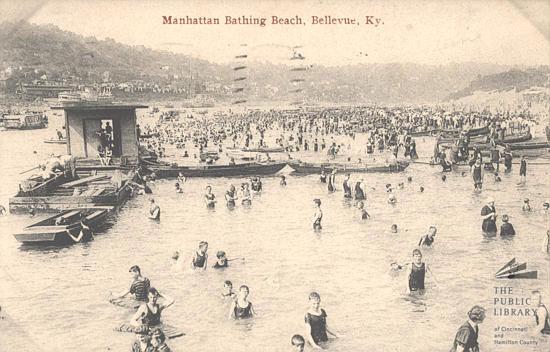 Hot summer days drove thousands to the beaches of Dayton and Bellevue.
This one, Manhattan Beach, was located at the foot of Walnut Street in Dayton (not Bellevue
as noted).
This beach was convenient for the Haunert families who lived just two blocks from this beach
on Second Avenue. Picture
ca. 1918 from Public Library of Cincinnati and Hamilton County http://memory.gclc-lib.org/
Mr. Charles R. Tharp is quoted from the Fall/Winter 1999 issue of Northern Kentucky Heritage, a publication of the Kenton
County Historical Society. "Most beaches were slowly dying by the late 1920's, due to the Corps of Engineers installing navigational
dams along the Ohio River and raising the pool stage above the 9 foot level."
It appears as if John or his property did not participate in the "beach boom" and stayed residential. Deeds were recorded
in 1910 giving a lot to five of his seven children.
The earliest deed transfer was for number 2 at 304 Second Avenue and went to John’s daughter, Sophia and her husband
Louis on 9 March 1910.
On 13 Aug 1910 the next lots were transferred. Joseph had lot number 4 at 308 Second Avenue while August received lot 7
at 316 Second Avenue. William and wife Mattie were transferred the deed to lot 6 at 314 Second Avenue on 26 April 1910.
The exact date is not known but the youngest child, Catherine, was given lot 3 at 306 between Sophia and Joseph before
March 1911 because her son Leonard was born there. They Braun family lived on Second Avenue only one year. They moved to the
country where Leonard grew up and thought it was a good environment to raise his children.
From 1914 to 1917, Henry Haunert and his children lived in Catherine’s house at 306. When Henry’s wife, Clara,
died in 1910, he was left with four children ranging in ages from five to seventeen. It’s easy to surmise that the support
system offered by neighboring relatives would help Henry with his young family. He moved back to Newport around 1918 after
his daughters married.
Son, Bernard did not receive a house, he was single and continued to live with his parents. Oldest son, Henry, also did
not receive a house and it is unknown why.
| Second Avenue Plot Map |
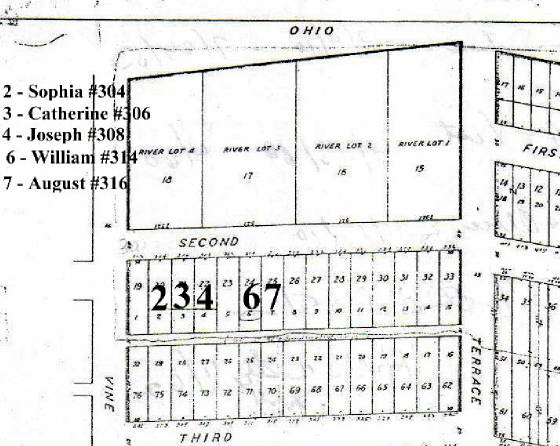
|
The first Haunert grandchild born in one of these homes was Herman John, son of Joseph and Victoria on 27 Oct 1910. The
last was probably Rosemary Speier, born August 1923.
All of the deeds record an exchange of one dollar. Though it was at first believed that the houses were gifts to the children,
Stell believes the houses were sold to the children at a good value. In 1920 the head of household indicates they own the
house with a mortgage on it.
Each house was 30 feet back from Second Avenue on the south side of the street. Behind Second Avenue an alley ran east
to west. On the north side of Second Avenue were four lots named simply "River Lot" and were probably vacant. North of these
lots lie the Ohio River, rising and falling from the beginning of time.
Two years after the Haunert families moved into their new homes on Second Avenue, the Ohio River hit left her boundaries
and rose above flood. In what later became known as the "Greatest Flood in Modern History" the Ohio River topped the 60-foot
level twice - in January 1913 it crested at 62.2 feet and at 69.6 feet in April. Newport and Dayton were hit particularly
hard by the April flood leaving 12,000 people homeless in Newport and 3,200 forced from their homes in Dayton. There is no
doubt that the Haunert families left their homes for higher ground.
The Ohio flooded again in 1937 and was the worst flood in the history of Northern Kentucky. Only three Haunerts remained
on Second Avenue, Joseph, August and Sophia. On January 24, the floodwaters were above 79 feet and meant that homes on Second
Avenue were most likely under water. They eventually sold their houses in the 50s and 60s having lived through 40-50 years
of flooding and recovery.
| 1997 - Foreground is Bellevue and beyond is Dayton |
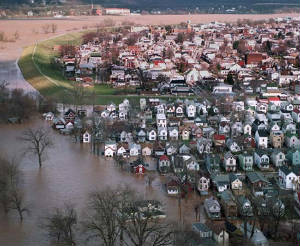
|
| Wall was built where 2nd Avenue once was and saved Dayton in 1997 |
In 1981 the city of Dayton built a floodwall to keep the city safe from future floods. The lots at Second Avenue are now
covered with the wall and all that is left are memories of the street and the beaches that once stood proudly on the waterfront.
The floodwall saved the city of Dayton in 1997 as the Ohio hit flood stage again.
As the Ohio’s floodwaters raged through the community in 1913, John and Theresia’s second son, Bernard became
extremely ill and was diagnosed with Tuberculosis. After three months, he succumbed in his parent’s home on Central
on 21 April 1913. He is buried next to his infant sister, Maria Theresia.
Tragedy struck John and Theresia again, two years later, as another son, William, lay dying from tuberculosis on Second
Avenue. A screened porch was built especially to help Will breathe more comfortably and he lived on that porch through the
fall and winter of 1915 until he died 21 Feb 1916.
| John and Theresia Weier Haunert Golden Anniversary |
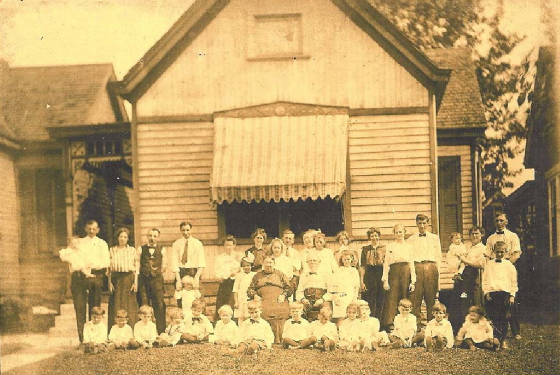
|
| All but one living family member is pictured here in front of Joseph Haunert's home on 2nd Avenue |
Probably still feeling the loss of their two sons, John and Theresia celebrated their Golden Wedding Anniversary on 15
May 1916. John is 73 and Theresia 69. Stell remembers this event because the date of her grandparent’s anniversary is
same as her birthday. She was seven years old and was given a place of honor at the celebration.
Sometime around 1917 or 1918 the senior Haunerts moved from their home of over thirty years on Central to Second Avenue,
however they did not sell the property. Stell remembers her grandparents lived first with their son Joe and then later moved
to daughter Sophia’s. They moved every few months so they would only burden one child for a brief period of time. Why
they did not live with son August is not clear.
Shortly after their move, John’s heart trouble became more serious and he was under the care of a doctor in early
June 1919. He was living with his daughter, Sophia, and on 13 June 1919 John passed away at age 76. He left his wife Theresia,
now 72, five children and thirty-four grandchildren. His death certificate says he is a retired harness maker but that is
difficult to understand given the length of time that John was a tailor. The cause of death was recorded as chronic myocarditis,
which can be attributed to advanced age but most importantly for John, his illness began during his Civil War service when
he experienced chest pains, shortness of breath and fatigue.
John’s funeral was held at his daughter Sophia’s home and the funeral Mass was from Corpus Christi in Newport.
He is buried at St. Joseph’s Cemetery on John’s Hill in Wilder, Kentucky beside his wife of over 50 years.
| John and Theresia Weier Haunert headstone |
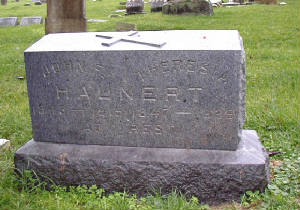
|
| St. Joseph's Cemetery, John's Hill, Campbell Co., Kentucky |
|